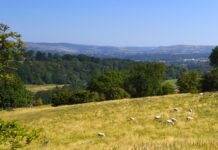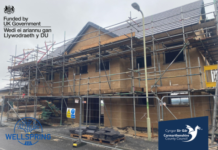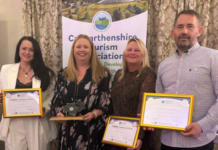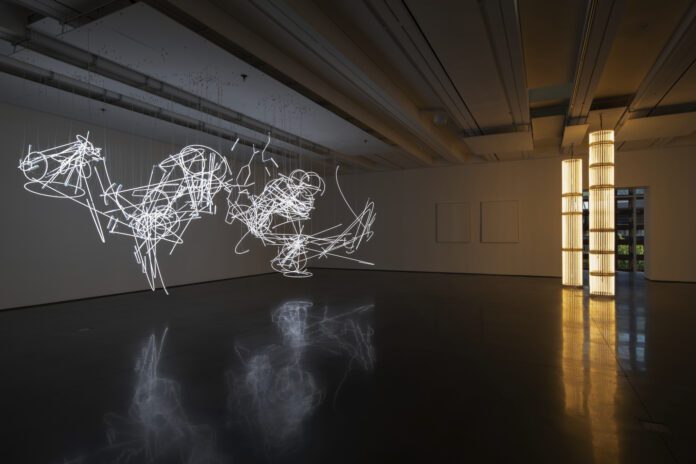8th October 2022 – 5th February 2023
A major solo exhibition by Cerith Wyn Evans, the most widely established and internationally recognised Welsh artist working today, is to take place this Autumn at Mostyn, Wales.
This will be a place-responsive exhibition, curated by Alfredo Cramerotti, Mostyn’s Director, with the presentation acting as a catalyst for discursive path and the largest show of work by the artist to be presented in the UK, and in his home country.
Wyn Evans’ work, especially his intricate neon sculptures, interrogate the idea of perception and question not only how we interpret the works, but also how we interpret their spatial surroundings as well as the broader systems of spoken, visual and written language. The neon works therefore are not simply neon, but forms of perceptions that allow visitors to immerse themselves into the exhibition environment, with the audience walking through, around and under a plethora of intricate light works, sound works, vibration works and transparencies. These will fascinate, seduce and at the same time challenge the perception of the visitor about what is art, about what it is to be a viewer, and what is communicated to us and from us within this environment. Wyn Evans’ work is a fully immersive, sensory exploration of the mind and body, our cognitive system and consciousness.

The visual narrative presented to the viewer will unfold through a sort of ‘controlled randomness’ throughout Mostyn, in which different artworks will be at once radical and romantic. Neon works will be suspended and isolated in space, sound will be emitted from suspended glass and aluminum panes through small directional speakers that play faint, tinkling notes or other barely audible sounds such as a faint radio signal. Seven metre high light columns will emerge from the floor as a subliminal forest of thought.
About the artist
Cerith Wyn Evans’ conceptual practice explores the way that ideas can be communicated through form, incorporating a diverse range of media including installation, sculpture, photography, film and text. He began his career as a filmmaker producing short, experimental films and collaborative works, but since the 1990s has created artworks that deal with language and perception, focusing with precise clarity on their manifestation in space. Evans employs strategies of exhibition making that are often site-specific, viewing exhibitions as a catalyst to produce a reservoir of possible meanings and discursive experiences.
His poetic work derives its refined aesthetic from a wide range of influences including film, music, literature and philosophy. Visual or textual sources and ideas are often repeated across different bodies of work, an indication of his desire to keep ideas in play or to bring them back to life as raw material for future use. He harnesses the potential of language to create moments of rupture and delight, where desire and reality conjoin, evident in his series of firework sculptures where wooden structures spell out open-ended texts and fleetingly burn over a designated period of time. These performative sculptures exist only as a durational event, but take on new life when documented through photographs or film. Likewise, in an ongoing series of neon text sculptures, he uses favourite passages of text or the subtitles from films to create open-ended, powerful works that produce a retinal after-image in the viewer.

Evans attempts to disrupt existing systems of communication, either through the practice of subverting certain given material forms, by altering spatial-temporal coordinates, or by adopting a communal rather than a singular authorial voice. In film and slide installations, for example The Curves of the Needle (2003), he manipulates sound to form a parallel ‘text’ to the visuals, where meaning is opened up by the unexpected slippage that occurs when the soundtrack is dislodged, changed or removed. With his series of chandelier sculptures he transforms these potent symbols of material wealth – whether minimal designs, modernist masterpieces or coloured, venetian glass antiques – into transmitters of morse code. The morse code, which is a translation of texts dictated by an adjacent computer, fills the room with a captivating otherworldly dance made of light and shadow.
Cerith Wyn Evans was born in 1958 in Wales and lives and works in London. He has exhibited extensively including solo exhibitions at Aspen Art Museum (2021), Pirelli HangarBicocca (2019), Museo Tamayo, Mexico City (2018); Duveen Galleries Tate Britain, London (2017); Museion, Bolzano, Italy (2015); The Serpentine Gallery, London (2014); TBA-21 Augarten, Vienna (2013); Bergen Kunsthall, Norway (2011); Tramway, Glasgow (2009); Inverleith House, Edinburgh (2009); Museo de Arte Contemporáneo de Castilla y León, Spain (2008); Musée d’art moderne de la ville de Paris (2006); and Kunsthaus Graz, Austria (2005). He has participated in the 57th Venice Biennale (2017); 4th Moscow Biennale (2011); 12th Venice Biennale of Architecture (2010); 1st Aichi Triennale, Japan (2010); 3rd Yokohama Triennale, Japan (2008); 9th Istanbul Biennial (2005); and 50th Venice Biennale (2003). In 2018 Evans won the Hepworth Wakefield Prize for Sculpture with his monumental work ‘Composition for 37 Flutes’, 2018.
Biography Alfredo Cramerotti
Alfredo Cramerotti is an author and curator of art and media formats. He is Director of Mostyn Wales, for which he has curated over 30 exhibitions since 2011, Advisor to the British Council Visual Arts Acquisition Committee and the Art Institutions of the 21st Century Foundation. He has organised international exhibitions, including the Ideal-Types series (Venice 2019 and Amsterdam 2018), Sean Scully at the Hong Kong Arts Centre (2018), Shezad Dawood: Leviathan at the Fondazione Querini Stampalia on the occasion of the 57th Venice Biennale (2017), EXPO VIDEO Chicago (2015) and three National Pavilions at the Venice Biennale (Mauritius 2015, Wales and Maldives in 2013). He also co-curated the biennial Sequences VII in Iceland (2015) and Manifesta 8 Region of Murcia (2010). He currently serves as President of IKT (International Association Curators of Contemporary Art), International Board Member of AICA (International Association of Art Critics), Executive Member of ICOM UK (International Council of Museums) and member of CIMAM (International Committee for Museums and Collections of Modern Art).
He has a PhD in Communication Design from the European Centre for Photography, University of South Wales, Cardiff, and is a Visiting Lecturer at several European and American universities. His academic work includes the theory and practice of hyper-imaging, which investigates the slippage of the image from representation to action/performance, and of aesthetic journalism, which addresses the relationship between art and elements of interview, documentary, fiction and reportage. He is editor-in-chief of the Critical Photography book series for Intellect Books and has published over 200 texts on art, media and curatorial practices, contributing to a large number of books, catalogues and monographs. His publications include Curating the Image: Notebook for a Visual Journey (2020); Forewords: Hyperimages and Hyperimaging (2018); Unmapping the City: Perspective on Flatness (2010); and Aesthetic Journalism: How to Inform without Informing (2009).
Help keep news FREE for our readers
Supporting your local community newspaper/online news outlet is crucial now more than ever. If you believe in independent journalism, then consider making a valuable contribution by making a one-time or monthly donation. We operate in rural areas where providing unbiased news can be challenging. Read More About Supporting The West Wales Chronicle


























